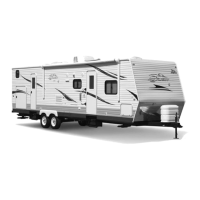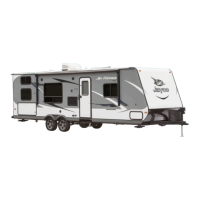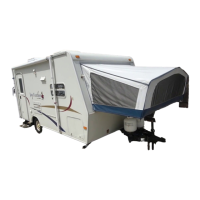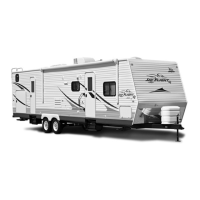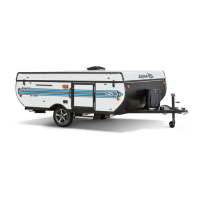97
from the water lines. When the water lines are nearly full, you may experience some
“air pockets.” Allow these to escape before closing the cold water supply faucets.
3. The water heater will ll rst, followed by the supply lines and faucets. Water heater
bypass valves must be open to allow water into the water heater, Refer to the Water
Heater Bypass section for an explanation on conguring the bypass valves. Bypass
valves are normally located near the water heater.
The fresh water connection should be unscrewed (i.e., the non-toxic drinking water hose dis-
connected) when the recreation vehicle is left unattended for any amount of time. If some-
thing would happen to the water system, this may help limit water damage to a smaller area.
1. Shut OFF the water at the pressurized water source.
2. Disconnect the non-toxic drinking water hose and reinstall the connection cap. The
connection cap should always be installed if the water ll is not in use.
You can ll the fresh water tank from a container of fresh water
and the gravity water ll inlet if you do not have access to City
Water.
The gravity ll will have a potable water label next to it. Do not
remove this label.
Low point and fresh water tank drains should be closed.
1. Remove the connection cap and insert a non-toxic drinking
water hose (or a funnel) into the gravity ll inlet. The other
end of the hose goes into a container of fresh potable water.
2. Pour the fresh water into the gravity ll until the tank is full.
3. Open both the hot and cold water faucets, along with outside
shower faucets (if so equipped) when lling the fresh water
tank to allow air pockets to be forced out of the system.
4. When the fresh water tank on the RV is full, remove the non-toxic drinking hose and
container from the gravity water ll. Replace the connection cap. This cap should al-
ways be installed if the water ll is not in use.
Draining The Fresh Water System
Water tanks may be drained through a valve located near the tank. A recreational vehicle
with a demand pressure pump system will have low-point drains attached to the water lines
(normally located near the water tank).
These low-point drains will release water in the supply lines by opening the valves and all
faucets. The water heater has its own drain plug. To drain the permanent
fresh water holding tank and supply lines:
1. Turn the water heater power OFF (turn o the electric and LP gas
switches).
2. Open all faucets, including the outside shower faucet (if so equipped).
3. Open the “fresh tank drain” valve. Methods to drain the fresh water
tank may vary by model. Fresh water tanks can be drained by one of
the following methods:
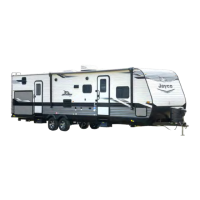
